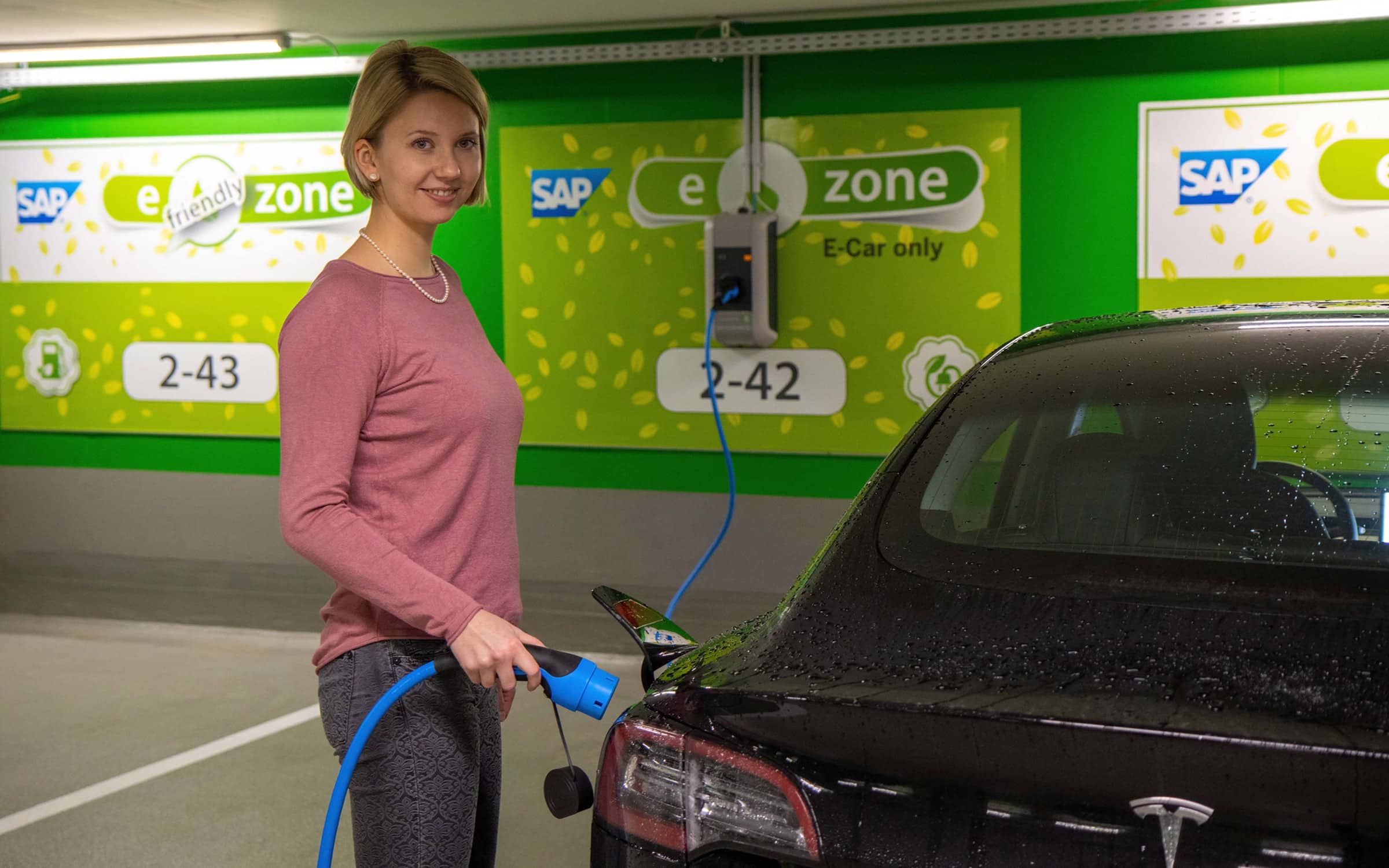Beginning with Austria, SAP is applying its own e-mobility enterprise software to achieve the goal of an emissions-free car fleet by 2030.
The e-mobility transformation is underway, and chances are good that you are witnessing it on the streets of your own town. More and more consumers are choosing electric-powered transport over the internal combustion engine, and this despite supply chain disruptions due to the ongoing global pandemic.
As battery range improves, charging infrastructure expands, and government incentives gain traction, the popularity of electric vehicles (EVs) appears to be taking off. According to the Electric Vehicle World Sales Database, in 2021 all regions witnessed strong increases in EV sales, with growth rates three to eight times higher than for the overall light-vehicle market. By 2026, according to a BCG study, EVs will account for more than half of light vehicles sold globally.
But there are still hurdles to overcome. Case-in-point is a charging infrastructure that is unevenly distributed and cannot keep up with demand. For example, Europe only has around 62 public charging points per 100,000 inhabitants, while the U.S. has roughly 37 charge points on the same per-capita basis. This is causing many potential EV converts to take a “wait-and-see” stance until they are assured of a viable charging infrastructure in their area.
The successful transition to e-mobility will therefore require huge investments in infrastructure and related technologies. Industry experts agree that demand can only be satisfied through a range of options, which includes semi-public charging options like privately run charging stations, office and retail parking lots, home garages, and government-provided locations.
SAP E-Mobility: Intelligent Charging Experience
Establishing a ubiquitous charge-point network is only one side of the coin. Charge-point providers will also need to provide consumers an easy, intelligent, and automated charging experience. Think of the one-click online-shopping experience consumers have become accustomed to and you get the idea. Achieving this level of service requires an intelligent software platform that is interconnected with other mobility-related business tasks and immediately recognizes the charging profile of your vehicle when you register at the charging point.
In September 2021, SAP launched SAP E-Mobility, a standardized, cloud-based solution that provides a complete package that enables charge point operators to run their business efficiently and profitably.
 “SAP E-Mobility is targeted at companies where mobility is the core business, such as logistics companies managing large vehicle fleets or mobility-as-a-service providers such as public transit, municipalities, and private ground transportation,” explains Ulrich Scholl, vice president and chief product manager for SAP E-Mobility.
“SAP E-Mobility is targeted at companies where mobility is the core business, such as logistics companies managing large vehicle fleets or mobility-as-a-service providers such as public transit, municipalities, and private ground transportation,” explains Ulrich Scholl, vice president and chief product manager for SAP E-Mobility.
The enterprise-grade capabilities of SAP E-Mobility offer integration with other software solutions for expense reimbursement management, analytics, cost management, billing, and invoicing.
Transition to an Emissions-Free Car Fleet by 2030
Since 2009, SAP has made sustainability a key pillar of its corporate strategy and annually discloses its own sustainability performance in an integrated report. It is only logical, therefore, that SAP would use the business software it develops to increase its own operational efficiency. This is exactly what the company is doing with SAP E-Mobility.
To make good on its promise to become carbon neutral by 2023, SAP is applying the standard solution for its own electric vehicles, which comprise nearly one-fifth of its total fleet of around 27,000 company cars. Battery electric vehicles have been part of the company’s fleet since 2010, and their share is growing as part of the company’s transition to an emissions-free fleet by 2030. Coupled with the decision to go 100% electric by latest 2030 is a pledge to employees that the charging infrastructure at its facilities can meet growing demand.
E-Vehicle Charging Infrastructure: Flexibility Is Key
The SAP Austria office in Vienna was the company’s first corporate location to implement SAP E-Mobility. Currently one-quarter of the 400 company cars at SAP Austria are battery electric vehicles, with a significant transition to electric planned in the coming years.

The charging infrastructure is operated by SAP’s facility management team in Vienna as part of its overall responsibility for asset management. Charging capacity is supplemented by a photovoltaic system that is also connected to the electricity grid.
 “Flexibility is key to any enterprise charging concept because employees want to be able to charge their cars at work, public charging points, and private charging points at home,” says Steffen Krautwasser, head of Global Car Fleet at SAP. “The operation of our charging infrastructure in Austria is based on our strategic adoption road map of SAP E-Mobility and marks a critical milestone for adoption at our other locations.”
“Flexibility is key to any enterprise charging concept because employees want to be able to charge their cars at work, public charging points, and private charging points at home,” says Steffen Krautwasser, head of Global Car Fleet at SAP. “The operation of our charging infrastructure in Austria is based on our strategic adoption road map of SAP E-Mobility and marks a critical milestone for adoption at our other locations.”
Strong fluctuations in office use during the pandemic have shown the importance of flexibility. Close coordination between the fleet manager and facilities manager in creating an adaptable strategy is of the utmost importance. SAP E-Mobility enables flexible charging at work and supports reimbursement of private charging at home via SAP Concur software for travel and expense management.
Charge-Point Sharing for Sustainable E-Mobility in Cities
Some cities and communities are looking to bridge the current shortage in public charging capacity by opening private charging infrastructure to the public. “Since the number of public charging stations is increasing more slowly than demand, it is particularly relevant to open up semi-public charging points to as many users as possible,” says Scholl.
This is where the versatility of SAP’s new solution comes through.
“SAP E-Mobility gives us the ability to open up access and billing options to any user, and we can scale the system to new requirements rapidly as required,” says Robert Diglas, head of regional facilities for SAP in Austria, Switzerland, Central Europe, and Ukraine. “For example, the flexible solution will enable us to open up our charging points to customers and business partners if and when we decide to do so.”
But SAP’s e-mobility vision extends well beyond the office parking lot. In 2021, the company started a co-innovation project with UnternehmerTUM, the city of Munich, and other partners from the mobility and energy industries. Together, they are developing new concepts based on Citizen Mobility to improve charge-point coverage in German cities.
The integration of private charge points is just one focus area, according to Scholl. “With SAP E-Mobility, we are just beginning to help our customers and partners turn mobility as a service into a reality,” he says. “The collaboration with innovative partners and real-life testing by citizens has delivered innovative use cases and thoughtful insights into how sustainable e-mobility, as one mode of urban transportation, can work in the future.”
Customers and partners can experience the SAP E-Mobility solution in action at the company’s e-mobility lab locations in Walldorf, Germany, and Bangalore, India.



